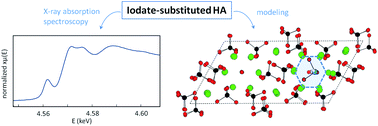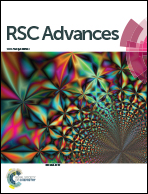Investigation of the local environment of iodate in hydroxyapatite by combination of X-ray absorption spectroscopy and DFT modeling†
Abstract
Iodate-substituted hydroxyapatites are novel phases of potential interest for the immobilisation of radioactive iodine-129. However, the local environment of the iodine in these phases is still unclear. Here, a combined experimental–computational strategy has been used to investigate the mode of incorporation of iodates (IO3−) in Ca–hydroxyapatite and Sr–hydroxyapatite lattices. On one hand, I K- and L3-edge XANES (X-ray Absorption Near Edge Structure) spectra are presented, showing that while the local structure around the iodate is similar in the two substituted hydroxyapatite lattices, it differs significantly from the one observed in a series of model compounds (NaIO3, KIO3, Ca(IO3)2·H2O). I K-edge EXAFS (Extended X-ray Absorption Fine Structure) spectra were then analysed, revealing the lack of order around the iodate, and also the absence of local clustering of the iodates along the hydroxyl columns of the apatite. Further insight into the local environment of iodates in apatites was then obtained by DFT (Density Functional Theory) computational modeling of iodate-substituted Ca–hydroxyapatite lattices.


 Please wait while we load your content...
Please wait while we load your content...